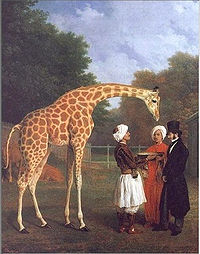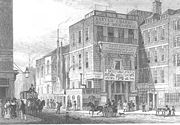
Edward Cross (zoo proprietor)
Encyclopedia


Zoo
A zoological garden, zoological park, menagerie, or zoo is a facility in which animals are confined within enclosures, displayed to the public, and in which they may also be bred....
proprietor and dealer in animals.
Cross was born in London
London
London is the capital city of :England and the :United Kingdom, the largest metropolitan area in the United Kingdom, and the largest urban zone in the European Union by most measures. Located on the River Thames, London has been a major settlement for two millennia, its history going back to its...
and baptised at St Andrew's, Holborn, presumably within days of his birth. Apart from the names of his parents, Walter Cross and Jane (née Callow), his early life remains obscure.
Cross worked for Stephen Polito
Stephen Polito
Stephen Polito was a menagerie owner of Italian descent in Georgian England.Polito was born in Italy. He owned a menagerie which he toured around England in the late 18th century...
, the owner of the menagerie
Menagerie
A menagerie is/was a form of keeping common and exotic animals in captivity that preceded the modern zoological garden. The term was first used in seventeenth century France in reference to the management of household or domestic stock. Later, it came to be used primarily in reference to...
at Exeter Exchange
Exeter Exchange
The Exeter Exchange was a building on the north side of the Strand in London, with an arcade extending partway across the carriageway...
in the Strand
Strand, London
Strand is a street in the City of Westminster, London, England. The street is just over three-quarters of a mile long. It currently starts at Trafalgar Square and runs east to join Fleet Street at Temple Bar, which marks the boundary of the City of London at this point, though its historical length...
. Cross's daughter married Polito's brother, and Cross bought the menagerie after Polito's death in 1814. The menagerie had been operated at that site from 1773 in competition with the Royal Menagerie at the Tower of London
Tower of London
Her Majesty's Royal Palace and Fortress, more commonly known as the Tower of London, is a historic castle on the north bank of the River Thames in central London, England. It lies within the London Borough of Tower Hamlets, separated from the eastern edge of the City of London by the open space...
with lions, tigers, monkeys, and other exotic species, all confined in iron cages in small rooms. The menagerie was primarily a visitor attraction open to the general public. It was visited by Wordsworth and Byron - who records watching the "tigers sup", being amused by a hyena's affection for its keeper, and the tricks played by an elephant with its trunk. Animals in the collection were painted by Edwin Landseer and Jacques-Laurent Agasse
Jacques-Laurent Agasse
Jacques-Laurent Agasse was an animal and landscape painter from Switzerland.Born at Geneva, Agasse studied in the public art school of that city. Before he turned twenty he went to Paris to study in veterinary school to make himself fully acquainted with the anatomy of horses and other animals...
. It was also visited by scientists such as Joshua Brookes
Joshua Brookes
'Joshua Brookes was a British anatomist and naturalist.He studied under John Hunter in London. He became a teacher of anatomy in London, and the founder of the Brookesian Museum of Comparative Anatomy.This private museum is described in his 1830 catalogue Museum Brookesianum Embracing an Almost...
and J. E. Gray. Gray named the Rhinoceros crossii in his honour (now as a synonym
Synonym
Synonyms are different words with almost identical or similar meanings. Words that are synonyms are said to be synonymous, and the state of being a synonym is called synonymy. The word comes from Ancient Greek syn and onoma . The words car and automobile are synonyms...
for the Sumatran Rhinoceros
Sumatran Rhinoceros
The Sumatran Rhinoceros is a member of the family Rhinocerotidae and one of five extant rhinoceroses. It is the only extant species of the genus Dicerorhinus. It is the smallest rhinoceros, although is still a large mammal. This rhino stands high at the shoulder, with a head-and-body length of ...
, Dicerorhinus sumatrensis).

Somerset House
Somerset House is a large building situated on the south side of the Strand in central London, England, overlooking the River Thames, just east of Waterloo Bridge. The central block of the Neoclassical building, the outstanding project of the architect Sir William Chambers, dates from 1776–96. It...
in March 1826. Cross attempted to sell the collection to the new Zoological Society of London
Zoological Society of London
The Zoological Society of London is a charity devoted to the worldwide conservation of animals and their habitats...
in 1826 and 1828, but the offer was refused on both occasions.
The Exeter Exchange was demolished in 1829, as part of general improvements to the Strand, and Cross moved the menagerie to the King's Mews near Trafalgar Square
Trafalgar Square
Trafalgar Square is a public space and tourist attraction in central London, England, United Kingdom. At its centre is Nelson's Column, which is guarded by four lion statues at its base. There are a number of statues and sculptures in the square, with one plinth displaying changing pieces of...
(now the site of the National Gallery). Some of the animals were sold to the new London Zoo
London Zoo
London Zoo is the world's oldest scientific zoo. It was opened in London on 27 April 1828, and was originally intended to be used as a collection for scientific study. It was eventually opened to the public in 1847...
in Regent's Park
Regent's Park
Regent's Park is one of the Royal Parks of London. It is in the north-western part of central London, partly in the City of Westminster and partly in the London Borough of Camden...
. In 1831, he sold the remaining animals to the Surrey Literary, Scientific and Zoological Institution - an institution that he had founded - for £3,500. Cross became superintendent of the new Surrey Zoological Gardens, and the animals were moved to Royal Surrey Gardens
Royal Surrey Gardens
Royal Surrey Gardens were pleasure gardens in Kennington, London in the Victorian period, slightly east of The Oval. The gardens occupied about to the east side of Kennington Road, including a lake of about . It was the site of Surrey Zoological Gardens and Surrey Music Hall.The gardens were the...
, in the grounds of Walworth Manor House in Kennington
Kennington
Kennington is a district of South London, England, mainly within the London Borough of Lambeth, although part of the area is within the London Borough of Southwark....
. Many of the exotic animals were housed in a large circular domed glass conservatory
Conservatory (greenhouse)
A conservatory is a room having glass roof and walls, typically attached to a house on only one side, used as a greenhouse or a sunroom...
, 300 feet (91.4 m) in circumference with more than 6000 square feet (557.4 m²) of glass. The collection expanded in the following years to include lion
Lion
The lion is one of the four big cats in the genus Panthera, and a member of the family Felidae. With some males exceeding 250 kg in weight, it is the second-largest living cat after the tiger...
s, tiger
Tiger
The tiger is the largest cat species, reaching a total body length of up to and weighing up to . Their most recognizable feature is a pattern of dark vertical stripes on reddish-orange fur with lighter underparts...
s, an Indian rhinoceros
Indian Rhinoceros
The Indian Rhinoceros is also called Greater One-horned Rhinoceros and Asian One-horned Rhinoceros and belongs to the Rhinocerotidae family...
, an orang-utan, and several giraffe
Giraffe
The giraffe is an African even-toed ungulate mammal, the tallest of all extant land-living animal species, and the largest ruminant...
s.
Cross retired in 1844, and he died in Kennington in 1854. His wife, Mary, predeceased him.
The zoo became run down after Cross retired, and the animals were sold off in 1856, to be replaced by Surrey Music Hall.

